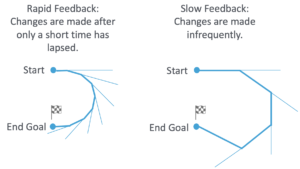So, you have a crack team delivering sterling work, who are highly skilled and hard working. But this team are not as productive as is hoped, and they frequently face production/service issues which take a lot of time to resolve. What gives?
Quite possibly, the team is delivering the wrong stuff (which does not improve the customer experience), or fire fighting issues blind because they don’t have the right information at the right time. Without regular feedback, projects can go off course, the wrong features can be built, and sometimes the wrong issue can be “fixed”!
How does feedback help?
-
Regular realignment of work
Feedback provides a way a realigning the work which is being done with the business goals. It also increases efficiency in the team as it reduces the length of time wasted following the wrong path. The faster and more frequent the feedback is, the more useful it is, and the more time and effort is saved.
The diagram shows the difference between making fast, frequent changes and infrequent ones. When feedback is timely, only small changes in direction are required (i.e. less effort and rework), but when feedback is not provided until later, a bigger change in direction is often required (e.g. system redesign).
Infrequent/slow feedback means the journey from starting a project to achieving the goal is much longer.
Rapid feedback is one of the keys to unlocking more efficiency in your organisation.
2. Reduce Risk
The ability to receive fast feedback reduces risk when delivering and maintaining systems (and can reduce blame in the team). Fast feedback reduces MTTR (mean time to recovery) and therefore reduces the risk of a major issue causing business impact.
3. Generative Culture
Fast feedback improves the team culture and motivation. There is greater transparency, employees can see that their work is useful to the business and job satisfaction increases. We are motivated to do our best when we can quickly, clearly and reliably see what is working well and what is not.
4. Innovation
The ability to fail fast and quickly determine the busines value of a project fosters an environment where innovation is encouraged. Innovative ideas and solutions are very valuable for businesses and also improve job satisfaction.
What does fantastic feedback look like?
Fantastic feedback is:
- Good quality (accurate and comprehensive).
- Fast. Even better if it is continuous!
- Easy-to-understand (clear and focused without overloading or distracting with superfluous information).
- Relevant to the business objectives. For example measuring current state against a business-impact goal.
- Available to all users.
How can you improve efficiency in your team by enabling fantastic feedback?
1. Implement Continuous Deployment and automation
- Automation and DevOps practices speed up processes by streamlining activities and reducing manual tasks
- They provide automated results to reduce the likelihood of things being missed
2. Build and use Dashboards
- Use dashboards to help your whole team get a better view of where we are now
- Ideally enable comparison with short and long term goals
3. Build a Minimum Viable Product (MVP)
- Building an MVP is often the quickest way to get real feedback from real users.
- Feedback from real users enables you (and them) to learn how users actually use the product rather than how you think it will be used or the capabilities discussed during requirements gathering. This is super valuable.
4. Business line teams rather than functional teams
- Teams which are aligned to the business needs are immediately more able to ask for and receive inputs directly from the business. This means the direction of the team can be constantly realigned to business goals and validated.
- Reduce handoffs between teams by opening lines of communication and having multi-functional roles working together in one team.
Find out More
Feedback is a key tenet of DevOps principles. Here at Sandhata, we have supported many of our customers on their DevOps journeys, helping them to achieve their business goals.
Take a look at our DevOps services, read some of our customer stories, or contact us to discuss how we could support you!
Bronwyn Davies
Latest posts by Bronwyn Davies (see all)
- Winner! Unicom Most Innovative Project 2023 - 27th February 2023
- Sandhata Gini – Our internal chatbot - 1st February 2023
- Goodbye 2022 - 19th December 2022


